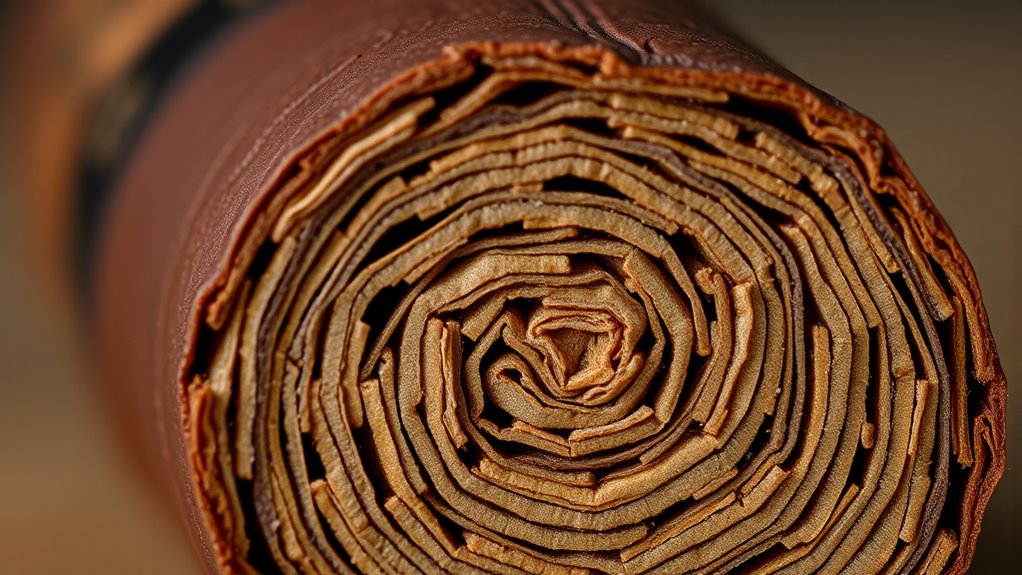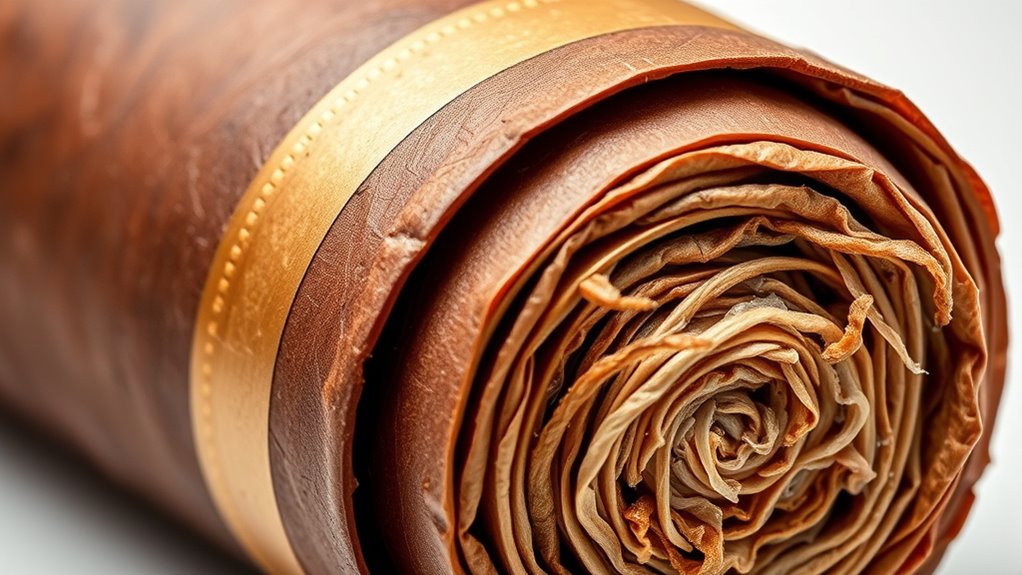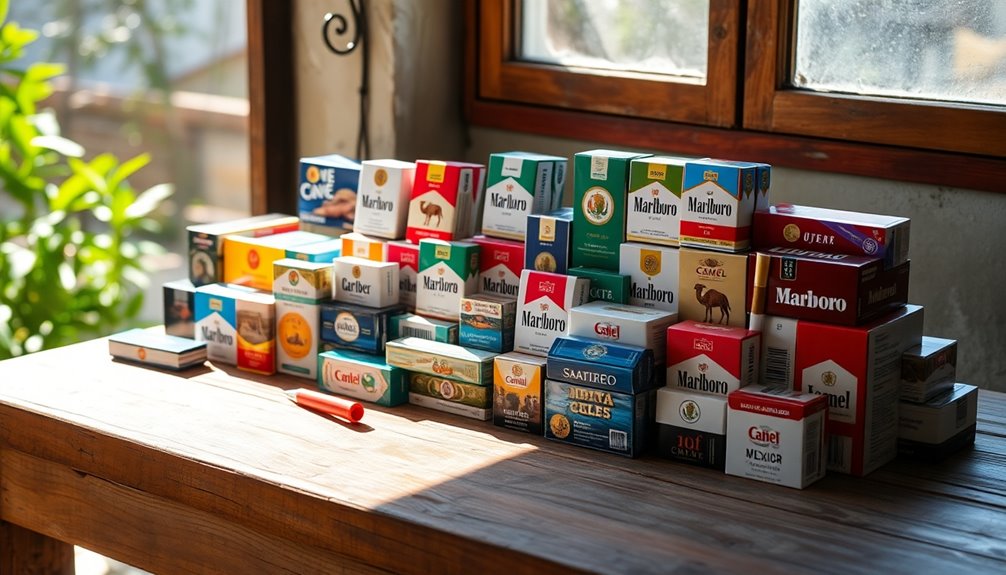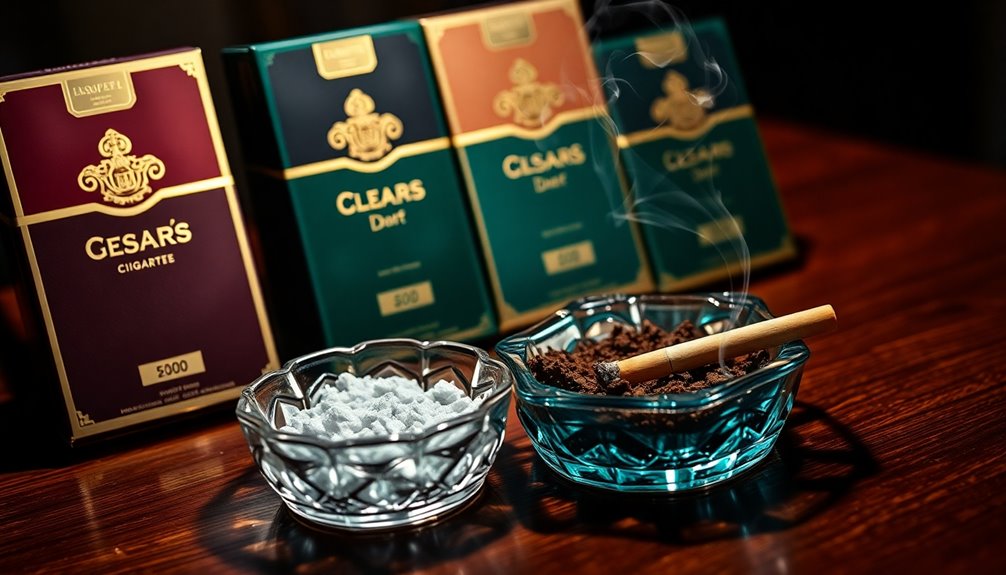A cigar’s anatomy includes three main parts: the wrapper, binder, and filler. The wrapper is the outermost leaf, influencing flavor, burn, and visual appeal; it often adds sweet, spicy, or earthy notes. Beneath that, the binder holds the filler together and impacts how smoothly the cigar burns. The filler, at the core, determines the cigar’s strength, aroma, and overall character. Understanding these components helps you better appreciate how each piece shapes your smoking experience.
Key Takeaways
- A cigar consists of three main parts: wrapper, binder, and filler, each influencing flavor and smoking experience.
- The wrapper is the outermost layer, affecting burn quality, flavor nuances, and aging characteristics.
- The binder holds the filler leaves together and impacts the cigar’s structural integrity and burn consistency.
- The filler is the core component, determining strength, aroma, and how the cigar develops during aging.
- Understanding each part helps appreciate the cigar’s craftsmanship and how flavors evolve over time.

A cigar’s anatomy consists of several essential parts that together influence its flavor, burn, and overall smoking experience. When you examine a cigar, you’ll notice three primary components: the wrapper, binder, and filler. Each part plays a vital role in shaping the cigar’s unique flavor profiles and how it ages over time. Understanding these components helps you appreciate the nuances of your cigar and how it develops with age.
A cigar’s flavor and burn are shaped by its wrapper, binder, and filler, each playing a vital role in its aging and complexity.
The wrapper is the outermost layer and often the most visually striking part of the cigar. It’s made from high-quality leaves that are carefully cultivated and cured to achieve the desired aroma and taste. The wrapper contributes significantly to the cigar’s flavor profiles, adding sweet, spicy, or earthy notes depending on the type of leaf used. It also influences how evenly the cigar burns, which is crucial for a smooth smoking experience. When you consider the cigar aging process, the wrapper’s qualities evolve, often mellowing and deepening in flavor. Proper aging allows the flavors from the wrapper to meld harmoniously with those from the filler, creating a more refined and complex profile. The aging process can also reduce harshness, resulting in a smoother draw. Additionally, the wrapper’s quality and type can impact the overall perception of the cigar’s authenticity and craftsmanship.
Beneath the wrapper, you find the binder, which holds the filler leaves together. The binder is usually a less premium leaf but still essential because it affects how the cigar burns and draws. It acts as a bridge, holding the filler in place and helping to maintain the cigar’s structural integrity. While the binder itself might not contribute as much to the flavor profiles as the wrapper, it influences the overall balance and burn quality. During the cigar aging process, the binder’s role becomes evident as it helps the cigar develop a more even burn and consistent flavor release. The interplay between wrapper, binder, and filler is crucial for achieving the desired smoking experience, with each part contributing to the cigar’s complexity.
The filler is the core of the cigar, composed of a blend of leaves that determine the cigar’s strength, flavor, and aroma. The filler’s quality and composition are central to the cigar’s character, and different blends can produce vastly different flavor profiles. When you consider aging, the filler leaves undergo chemical changes that deepen and soften their flavors, often enhancing the overall profile. The aging process allows the cigar to mellow, balancing the strength with nuanced flavors. The blend’s composition and how it ages define the cigar’s personality, making it essential to choose well-crafted filler for a memorable smoking experience. Overall, understanding the cigar anatomy helps enthusiasts select and enjoy cigars that develop complexity and richness over time.
Frequently Asked Questions
How Does Cigar Age Affect Wrapper Quality?
When you age a cigar, the aging process can improve the wrapper quality by mellowing its flavors and reducing harshness. Over time, the wrapper’s deterioration slows, preserving its integrity and appearance. Proper aging allows the cigar to develop more complex aromas, making your smoking experience richer. However, if aged too long, the wrapper might become brittle or lose its vibrant color. So, moderation helps maintain a perfect balance.
Can Different Binder Types Change the Cigar’s Flavor?
Different binder types can definitely change your cigar’s flavor. Binder flavor variations come from the specific leaves used and the binder manufacturing processes, which influence how the flavors blend with the filler and wrapper. For example, a Connecticut binder might add subtle sweetness, while a Maduro binder could introduce richer, more robust notes. These differences allow you to experience unique flavor profiles, enhancing your smoking experience based on the binder’s characteristics.
What Are Rare Filler Tobacco Varieties?
You’re in luck if you crave rare filler tobacco varieties. These include varieties like Cuban seed, which boasts unique flavor profiles, or exotic strains like Ecuadorian or Peruvian tobaccos. These rare tobacco strains often come from specific regions, making your cigar a true masterpiece of flavor. They’re like the secret ingredients in a gourmet dish—hard to find but worth the hunt for those seeking extraordinary cigars.
How Does Climate Influence Wrapper Cultivation?
Climate impact notably influences wrapper cultivation because temperature, humidity, and sunlight affect leaf quality. You’ll find that ideal conditions produce smoother, more flavorful wrappers, while adverse weather can cause blemishes or uneven coloring. Consistent warmth and moisture help leaves develop the right thickness and texture, ensuring a premium wrapper. So, when climate varies, it directly impacts the quality and appearance of the wrapper, shaping the overall cigar experience you enjoy.
Are There Health Differences Between Wrapper Types?
You might notice health differences between wrapper varietals, as some, like Connecticut or Maduro, contain higher levels of nicotine and certain chemicals. These variations can impact health implications, especially if you’re sensitive or smoke frequently. Lighter wrappers generally have fewer chemicals, but all cigars pose health risks. Always consider these factors, and remember moderation is key to minimizing potential health effects associated with different wrapper types.
Conclusion
Understanding the layers of a cigar is like peeling back the petals of a flower—you discover more richness and complexity with each layer. Knowing about the wrapper, binder, and filler helps you appreciate the craftsmanship behind every puff. When you recognize what’s inside, each cigar becomes more than just smoke; it’s a carefully crafted story waiting to be explored. So next time you light up, remember—you’re holding a masterpiece in your hands.










